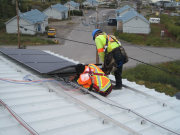This Earth Day, as we envision a clean, affordable and equitable energy future, we need to look beyond traditional centralized solutions and large-scale energy infrastructure projects like big power plants situated far from where the energy is used. Canada’s path to a low-carbon economy must be grounded in the everyday actions of households, communities and local utilities. This can be achieved by unlocking the full potential of utility demand-side management (DSM), which involves altering consumers’ consumption patterns to ensure grid stability, optimizing energy use and integrating distributed energy resources (DERs).
There are three approaches that fall under the umbrella of DSM: energy efficiency, demand response, and DERs. Traditionally, DSM has meant the first two approaches, through activities such as upgrading lighting, installing better insulation or incentivizing electricity use during off-peak hours. These interventions remain valuable, but DSM has evolved. To fully realize Canada’s climate objectives and ensure affordable and accessible energy for all, we must unlock that third approach.
DERs are local, customer-based energy resources that include a growing array of technologies located in and on our buildings: rooftop solar, battery storage, and electric vehicles. These technologies can be coordinated to support the performance of the electricity grid, reduce emissions, and provide economic benefits to building owners, utilities and utility customers.
While DERs are already in place, without clear policies, regulations, and utility mandates, their full value will remain untapped. Local utilities are well-positioned to coordinate these assets, unlocking new revenue streams and increasing market participation. With the right tools and incentives, utilities can support customer-driven participation in programs that improve system efficiency and grid reliability and reduce carbon emissions — particularly in underserved or equity-deserving communities.
To move forward, demand-side management must evolve from a series of disconnected programs to a more strategic, integrated approach. This means empowering utilities to treat on-site DER as core infrastructure investments for affordability, emissions reduction and resiliency. It also requires aligning provincial policies and regulations so that utilities can enable the aggregation of customers’ own solar panels, batteries and other DERs and compensate them fairly. And crucially, the benefits of these programs must reach those who have the most to gain: low- and moderate-income households, renters, Indigenous communities, and all others who are often excluded from clean energy opportunities.
This Earth Day, we’re reminded that climate action is not just a national imperative, it’s also inherently a local one. The clean energy future won’t be built solely through transmission lines or centralized electricity generation. It will be shaped by what’s happening in our basements, on our rooftops, and within our neighbourhoods and communities. By supporting local utilities to deliver modern, inclusive DSM programs that combine grid-enhancing technologies from local systems, we can help ensure affordable, accessible and reliable clean energy. The transition is underway. Now we need to enhance it, making sure it works for everyone.









